PART VI
Fire Construction Work And Handicraft
Cooking Altar (23). A cooking altar, or elevated fireplace, will be found convenient in a permanent camp or on a regular hiking ground for either cooking or the night council fire.
Notch and lay logs in log cabin fashion to the height desired for the top of the altar. Fill this in with stones and earth, or lay small green sticks across the top logs and cover them with small stones, earth or sod. For a more permanent fireplace, the top may be covered with cement or sheet metal.
Any type of fireplace may be erected on top of the altar. The one illustrated is a stone modification of the trapper fire. The swinging pot-hanger in the rear is described in detail in Swinging Crane No. 29.
Durable Woods. Select for foundation logs heavy pieces of durable wood, such as catalpa, red cedar, cherry, cypress, butternut, locust, sassafras, white oak, yellow pine.
1. How would you build a cooking altar without logs?
2. What other kind of pot-hangers would be good?
3. Could you interest a group in erecting a permanent cooking altar in a public park as a community good turn?
4. How do you account for the fact that people rarely use natural altars such as boulders?
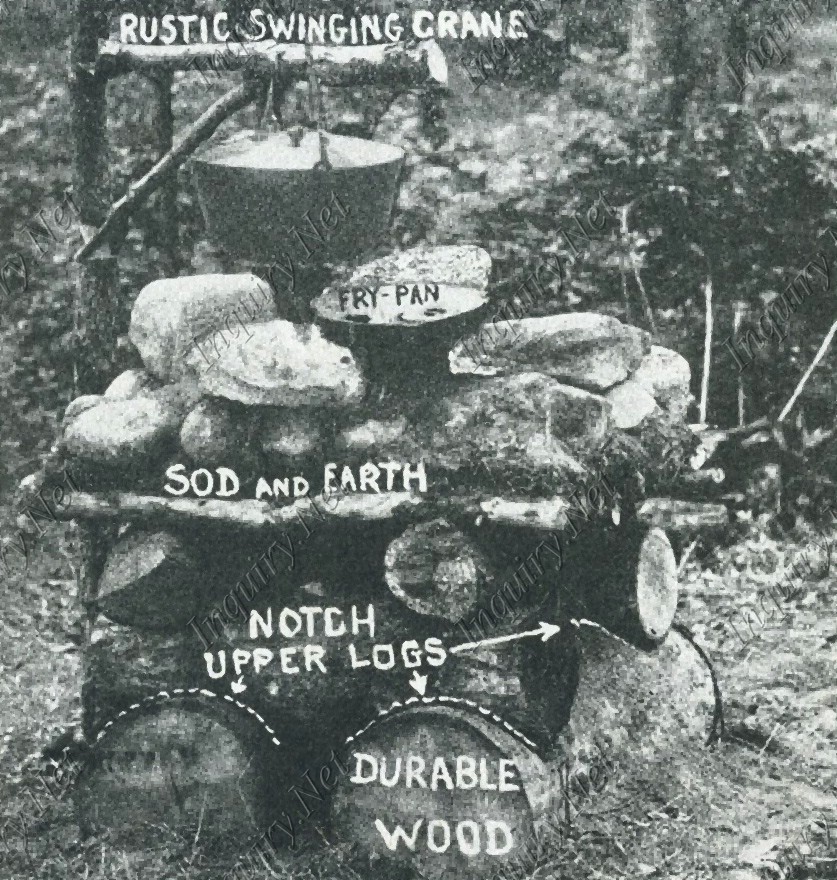
Cooking Altar Altar with Crane
Camp Fire Altar (24). For an all-summer camp it is advisable to build an elevated fireplace in the center of the council ring, similar to the Cooking Altar No. 23.
Drive a metal pipe into the center of the altar so that it projects a foot or more. Fasten to the top of the pipe a metal cross or a metal wheel in a horizontal position. This arrangement holds the firewood in wigwam shape, permitting an unobserved high flame, so that a comparatively small fire will illuminate a large circle. Camp fire games and challenges can then be conducted without danger of the players falling into the fire.
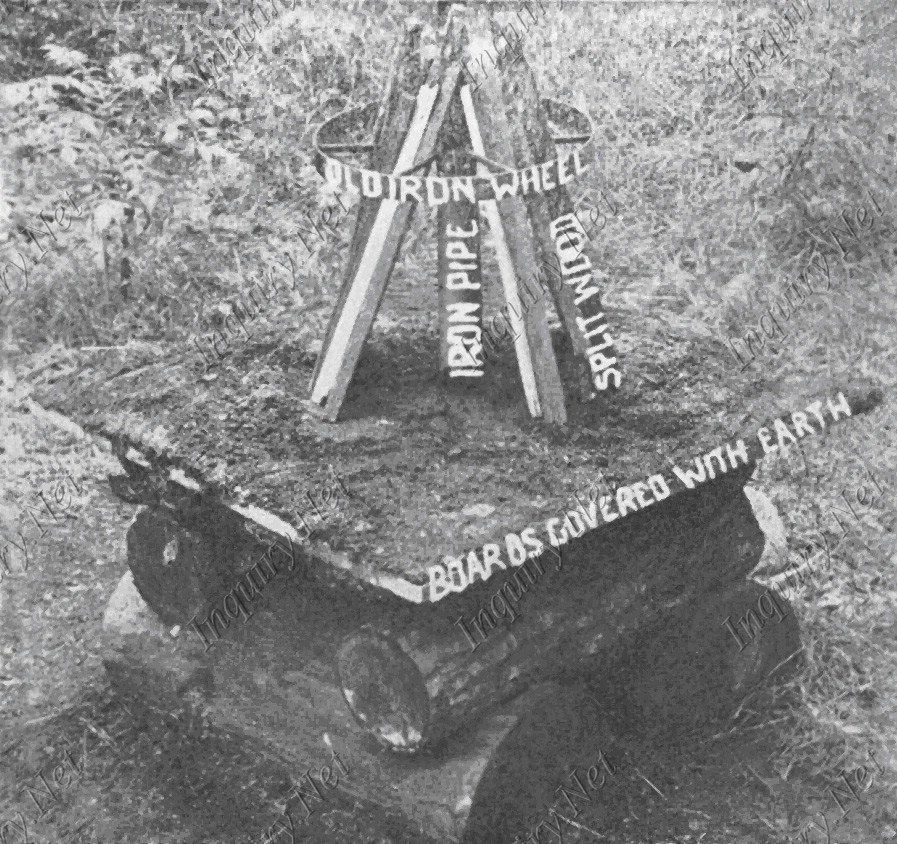
Permanent Camp Fire Altar
1. What kind of a fire would you build for a council ring in cold weather, to produce both heat and light?
2. Why do many camp directors light camp fires without matches and with ceremony?
3. Do you prefer a log cabin method for holding the firewood in position to the metal structure above?
Single-Stick Pot-Hangers (25). A single-stick pot-hanger, also called a saster, wambeck, or spygelia, is generally used when a single kettle or pot is to be hung over an open fire.
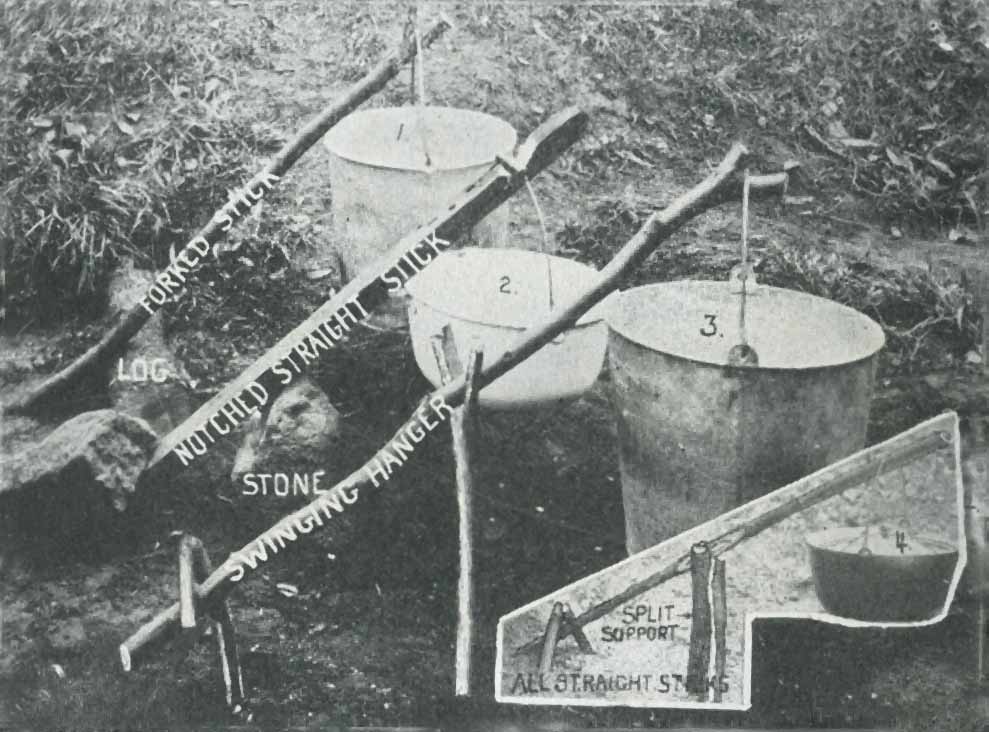
Single-Stick Pot-Hangers
Hanger No. 1. The end of this hanger is pointed and driven into the ground. The log that supports it may be placed in various positions to regulate the height of the pail.
Hanger No. 2. This model is especially recommended for use upon stone or very hard ground, where it would be difficult to drive a stick.
Hanger No. 3. This is the rustic type of hanger most often illustrated, but unfortunately it is the least economical because three forked sticks are required to make it.
Hanger No. 4. This model, made without forked sticks, illustrates a modification of No. 3. The combination of a split stick with a straight stick driven in front of it is substituted for the forked upright. The hanger is secured to the ground by driving, at an angle, a straight stick on each side of it.
1. On which side of the firs with reference to the wind should the hanger be placed?
2. Which hanger can be most easily raised or lowered?
3. Which of the hangers do you prefer? Why?
4. How would you hang your pot if you built your fire at the base of a steep bank?
Camp Crane (26). A camp crane should be used when more than one pot is to be hung over an open fire. Select for the cross-stick, also called lug-pole or lug-stick, a piece of stiff green wood about as thick as a broomstick. Forked sticks are usually illustrated for uprights in spite of the fact that they cause unnecessary destruction of wood, and are difficult to drive. Straight split sticks answer the purpose just as well as the usual forked sticks. The construction: on the right illustrates a method of using a split lug-pole, while the one on the left illustrates a split upright. The insert shows how seasoned wood that splits easily may be used for split uprights. The pail No. 1 is hung over the end of a long pole which is simply placed on the cross-stick, without being driven into the ground. No. 3 illustrates an excellent method of improvising a double boiler.
Woods Difficult to Split. The following woods are good for the cleft sticks- because they do not split readily, especially when green: buckeye, elm, gum, cherry, maple, tupelo, hemlock, locust, sycamore. Saplings do not split as easily as mature branches.
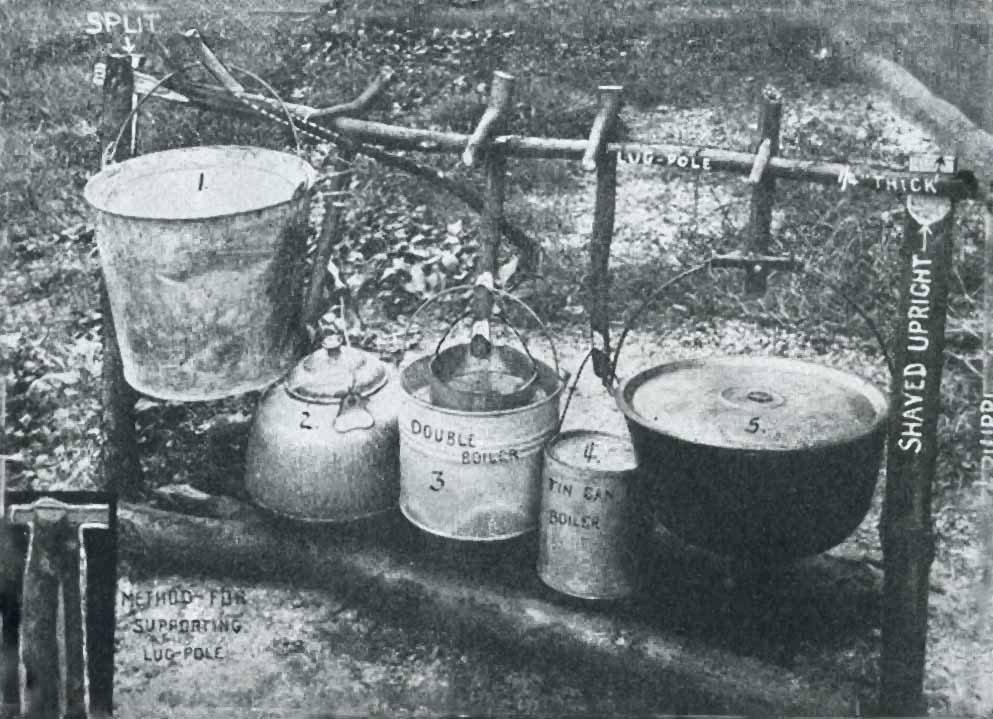
Camp Crane or Trammel
1. How would you drive a forked upright?
2. Would you object to the "citified" method of driving nails into the uprights and laying the lug-pole across them?
3. Would you split and cut the uprights to shape before or after driving them?
4. Would you recommend a metal crane for a permanent camp?
Pothooks (27). The "Pothooks or Pot-Claws" photograph below illustrates a close-up view of the pothooks shown in use in the Camp Crane No. 26. Pothooks are known by many names including pot-claws, pot-chips, gib-crooks, gallows-crooks, and hakes.
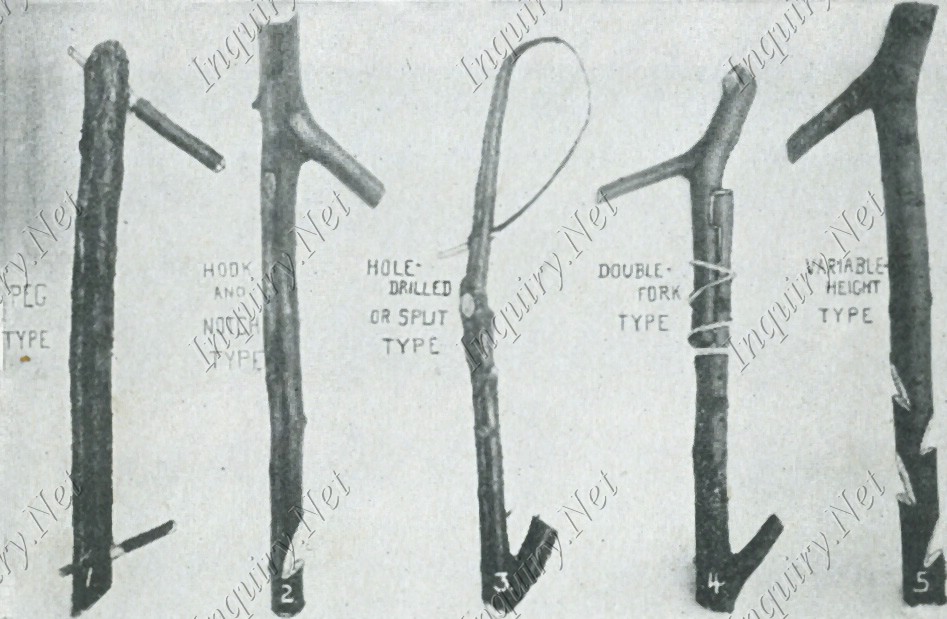
Pothooks or Pot-Claws
Pothook No. 1. The first pothook has much to recommend it because it is made without the use of a forked stick. To make it, select a stick of the length required, bore holes with a scout knife at each end at an angle, as illustrated, and fit wooden pegs into these holes. Is there any objection to substituting nails for pegs?
Pothook No. 2. Notice that the hook and notch are on the same side of the main stick. This is often made with a notch cut on the other side similar to No. 4. Which do you think is better?
Pothook No. 3. The upper part of this is made by drilling a hole through the main stick and passing through it the end, which is shaved down to the bark. A split may be used instead of a hole if you have no borer on your knife.
Pothook No. 4. This is made by cutting two forked sticks, as illustrated, and nailing or lashing them together with a piece of bark, root, or wire. This is an interesting piece of handicraft but ha3 little to recommend it as a pothook.
Pothook No. 5. This is an excellent form of pothook that may be used for hanging a pot at different heights. It is illustrated in use in Camp Crane No. 26 for hanging a double boiler.
1. Which of these pothooks do you prefer? Why?
2. Do you object to the use of manufactured metal chain hangers?
3. Would you advise doing away with rustic pothooks and substituting for them straight sticks with nails driven into them?
Rustic Broilers (28). These fascinating pieces of handicraft may be used repeatedly if they are made from stout branches, and the broiling or toasting is done over a bed of embers without flame.
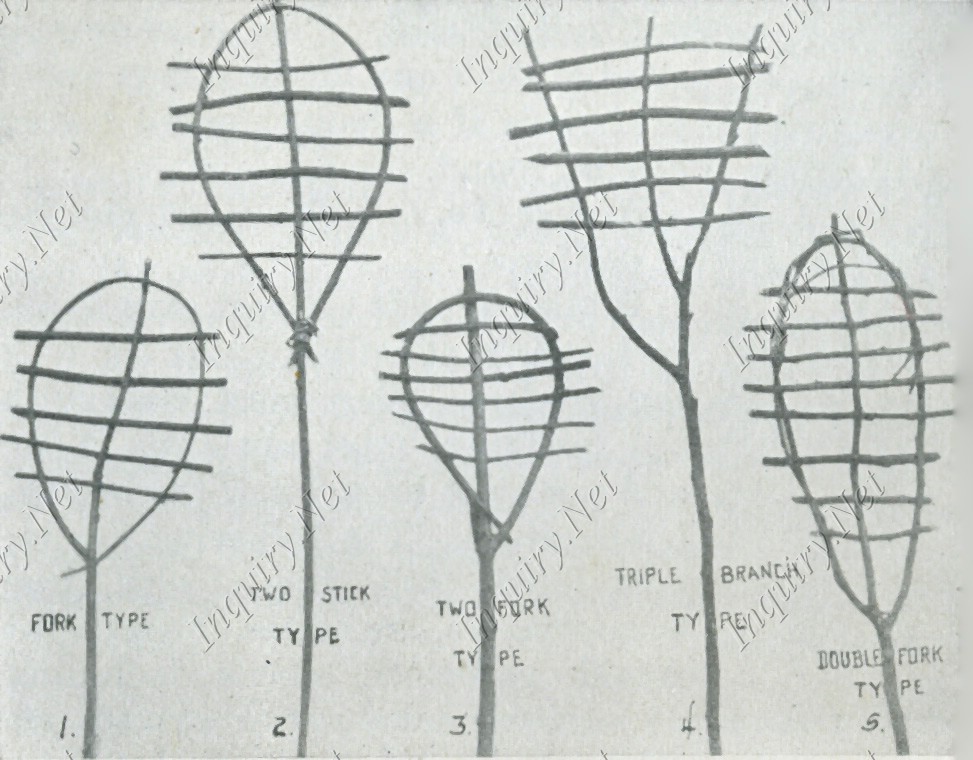
Rustic Broilers or Toasters
Broiler No. 1. Split the, stem below the fork or bore a small hole through it at an angle, as illustrated. Bend the end of the branch and cut it to a size that will fit tightly into the hole in the main stem. Weave cross-sticks, at least as thick as a lead pencil, alternately over and under the central stem.
Broiler No. 2. This is made without the use of a forked branch. The bent stick may be secured either by lashing, as illustrated, or by the method described for broiler No. 1.
Broiler No. 3. This can be made without difficulty if you are fortunate enough to find a branch forked just right.
Broiler No. 4. This simple broiler serves the purpose as well as any of the others.
Broiler No. 5. This is more substantial than any of the others and is preferable if a double forked branch can be found.
Broiler No. 6. This illustrates No. 5 reinforced.
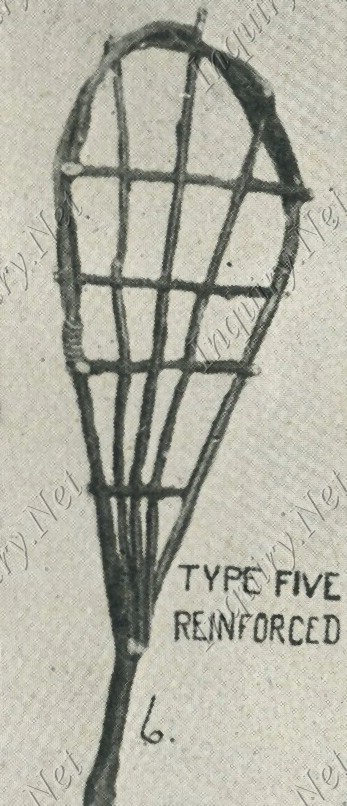 Broiler Woods. Great care should be taken in selecting woods for making
broilers. They must bend without breaking, must not taste bitter, and must not
burn below the broiling temperature. The following are recommended: ash, beech, elm, iron-wood, maple, sassafras, sweet gum.
Broiler Woods. Great care should be taken in selecting woods for making
broilers. They must bend without breaking, must not taste bitter, and must not
burn below the broiling temperature. The following are recommended: ash, beech, elm, iron-wood, maple, sassafras, sweet gum.
Avoid poisonous woods including: laurel, poison ivy, poison oak, poison sumac, and rhododendron. The tannic acid in most of the nut and acorn bearing trees tends to make the meat taste bitter. Beech and hickory, however, seem to be exceptions.
Rustic Swinging Crane (29). This is a useful and interesting woodcraft project for a permanent fireplace. Secure a straight stick for the upright and (if you are lucky enough to find it) a double forked branch for the swinging arm. Nail or lash a piece of tin or tough bark to the end of the forked branch. After the upright is driven, cut a notch completely around it to fit the fork of the swinging arm.
Lashing Material. Lashing may be made from bark, rootlets, branches, vines, grasses, and hemp. Both the bark and withes (flexible slender twigs or branches) of smooth-barked trees that peel easily, may be used. Small trailing rootlets of the following trees are good: cedar, cottonwood, hemlock, fir, spruce, tamarack. The beaten inner fibrous bark of the following trees was used by Indians: basswood, buckeye, cedar, elm, hickory, locust, leatherwood, mulberry, osage-orange, white oak. Remember : lash with a clove hitch.
1. How would you make the lower end of the swinging arm if you could not find a properly forked branch?
2. Could you make a practical swinging crane from straight sticks only?
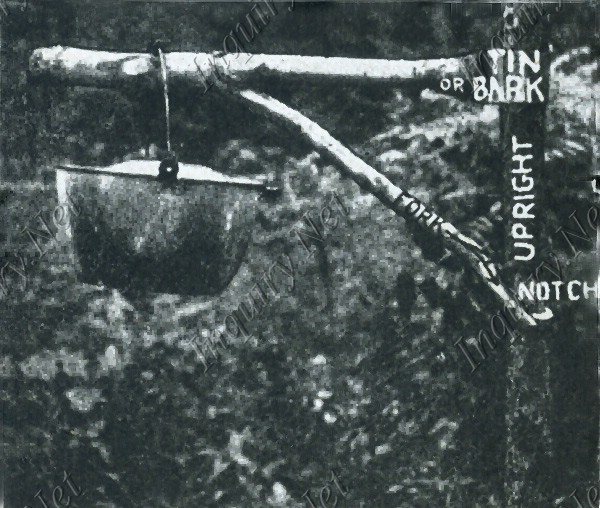
Rustic Swinging Crane
3. Could you use pipes and pipe fittings to make a swinging crane for a permanent fireplace?
Iceless Refrigerators (30). The construction of iceless refrigerators appeals to boys and girls on overnight trips.
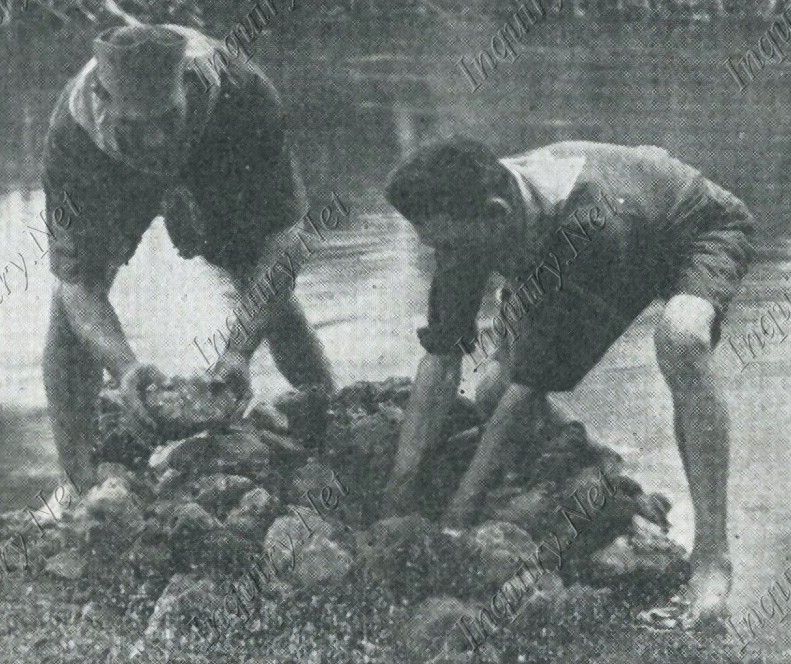
Refrigerator No. 1
Refrigerator No. 1. This is the simplest refrigerator possible when, a stream of water is available. The food is stored on stones placed in the water. The top should be closed to keep out animals.
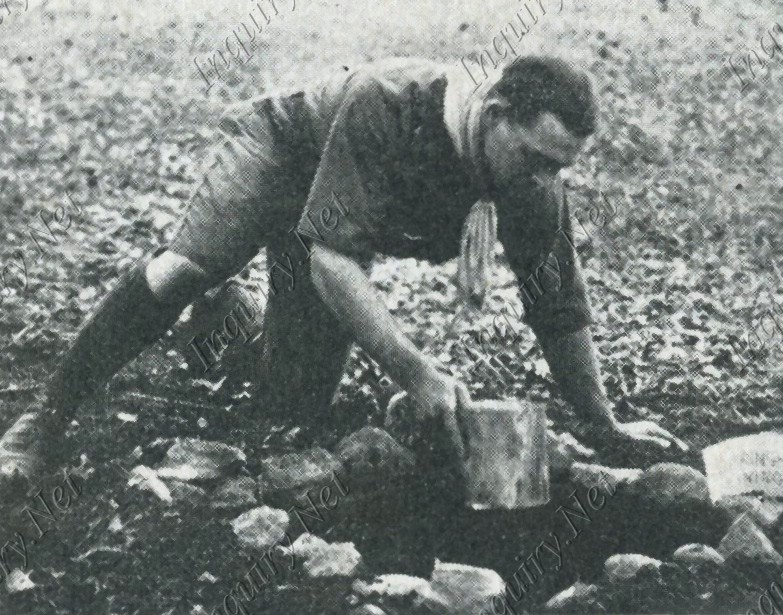
Refrigerator No. 2
Refrigerator No. 2. When water is not available, dig a hole, line it, and close it in, as illustrated.
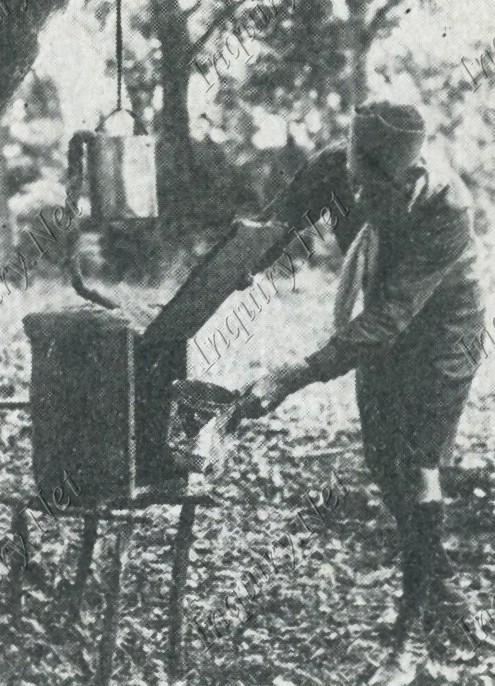
Refrigerator No. 3
Refrigerator No. 3. When time permits and the necessary materials are available, an excellent box refrigerator can be made. Cover an empty box with a wet burlap bag, or with canvas. If this is kept moist constantly, the evaporation of the moisture will keep cool foods stored within the box. Keep the burlap moist by the use of wicking, as illustrated; or better still, hang a perforated old tin can over the box and occasionally fill it with water.